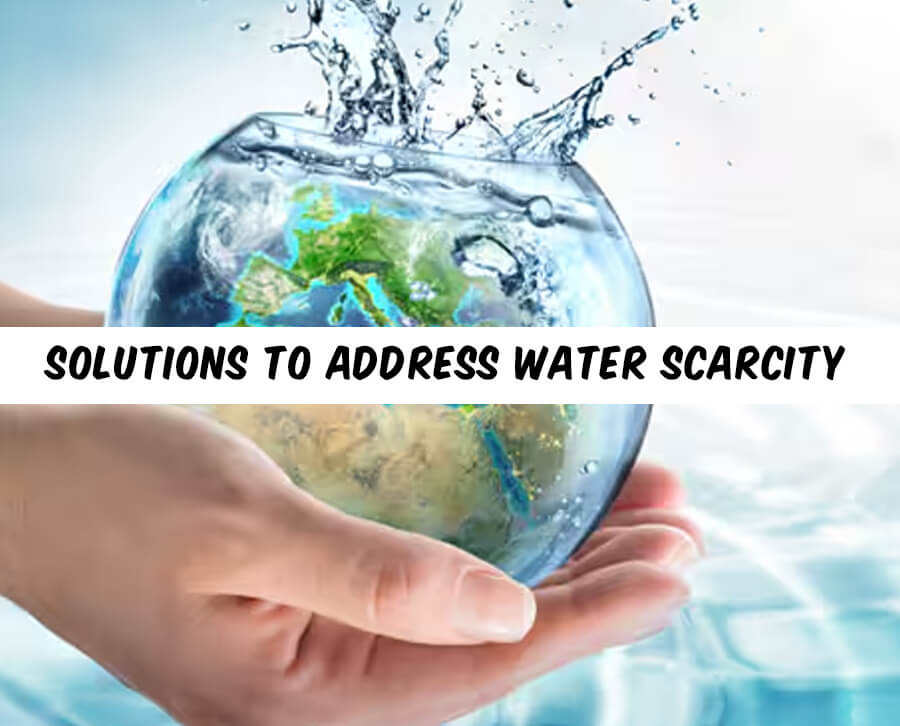 Water scarcity is a pressing issue that plagues many regions across the globe, and Pakistan is no exception. With a rapidly growing population, climate change effects, and mismanagement of water resources, the country faces an imminent threat to its water security. In this article, we delve into the root causes of water scarcity in Pakistan and explore innovative solutions to tackle this crisis.
Water scarcity is a pressing issue that plagues many regions across the globe, and Pakistan is no exception. With a rapidly growing population, climate change effects, and mismanagement of water resources, the country faces an imminent threat to its water security. In this article, we delve into the root causes of water scarcity in Pakistan and explore innovative solutions to tackle this crisis.
-
Understanding Water Scarcity in Pakistan:
Pakistan is predominantly an arid to semi-arid country, heavily reliant on the Indus River system for its water needs. However, this vital resource is under severe strain due to various factors such as inefficient irrigation practices, urbanization, pollution, and climate change. According to recent reports, Pakistan is among the most water-stressed countries globally, with per capita water availability plummeting dangerously low.
- The Indus River System: Lifeline Under Threat The Indus River system, upon which Pakistan heavily relies for its water needs, faces multifaceted challenges. Subhead: "Rivers in Peril: The Dwindling Flow" The once mighty Indus River and its tributaries are dwindling due to various factors, including glacial melt, erratic precipitation patterns, and unchecked exploitation. This diminishing flow directly exacerbates water scarcity across the country, particularly in rural agricultural regions.
- Agricultural Agony: Struggles in the Fields Pakistan's agriculture, which forms the backbone of its economy, bears the brunt of water scarcity. Outdated irrigation techniques, such as the prevalent but inefficient flood irrigation, exacerbate water wastage, leading to reduced crop yields and economic instability for farmers.
- Urbanization and Industrialization: Pressure Points Amplified as Pakistan experiences rapid urbanization and industrial growth, the demand for water escalates, intensifying pressure on already strained water resources. Subhead: "Urban Expansion: Thirsty Cities" Urban centers are expanding rapidly, placing immense strain on local water sources. Inadequate infrastructure and poor water management exacerbate the situation, leading to water scarcity, particularly in densely populated urban areas.
- Industrial Thirst: Balancing Development and Conservation Industrialization brings economic growth but also intensifies water consumption. Industries must balance their developmental needs with responsible water usage to prevent further depletion of water resources and environmental degradation.
- Climate Change: Unpredictable Patterns, Unprecedented Challenges Climate change exacerbates Pakistan's water woes, manifesting in unpredictable weather patterns, prolonged droughts, and devastating floods. Subhead: "Climate Crisis: Adapting to a New Normal" Pakistan must adapt to the realities of climate change by implementing resilient water management strategies, including drought-resistant crop varieties, water-efficient technologies, and disaster preparedness measures.
- Innovative Solutions: Charting a Course Towards Water Security Despite the daunting challenges, Pakistan has the potential to address water scarcity through innovative solutions and concerted efforts. Subhead: "Revolutionizing Agriculture: Precision Irrigation Techniques" Adopting precision irrigation techniques, such as drip and sprinkler irrigation, can significantly reduce water wastage in agriculture while improving crop yields and farm profitability.
- Harnessing Nature's Bounty: Rainwater Harvesting Rainwater harvesting presents a decentralized solution to water scarcity, allowing communities to capture and store rainwater for various uses, including irrigation, drinking, and sanitation.
- Embracing Desalination: Tapping into Coastal Resources Pakistan's extensive coastline offers opportunities for desalination, providing a sustainable source of freshwater for coastal communities. Investing in desalination infrastructure can alleviate pressure on freshwater sources and enhance water security in coastal regions.
- Policy Reforms: Enabling Change Through Governance Effective water governance, backed by robust policies and regulations, is essential for managing water resources sustainably. Governments must prioritize water conservation, promote efficient water use practices, and invest in infrastructure to ensure equitable access to water for all citizens.
-
The Impact of Water Scarcity:
The repercussions of water scarcity in Pakistan are multifaceted, affecting not only agricultural productivity but also human health, sanitation, and industrial development. Farmers struggle to irrigate their crops, leading to reduced yields and economic losses. Additionally, inadequate access to clean water jeopardizes public health, contributing to the spread of waterborne diseases such as cholera and typhoid.
- Agricultural Adversity: Crop Yields Dwindle Subhead: "Farmers' Dilemma: The Wilted Harvest" For Pakistan's agrarian economy, water is synonymous with life. However, dwindling water resources and inefficient irrigation practices translate into reduced crop yields, financial losses, and heightened food insecurity for farmers. With each passing season, the specter of failed harvests looms large, perpetuating a cycle of poverty and vulnerability.
- Public Health Perils: Contaminated Waters Breed Disease Subhead: "Tainted Wells, Ailing Communities" Inadequate access to clean water sources exposes millions of Pakistanis to waterborne diseases, ranging from diarrheal illnesses to more severe conditions like cholera and typhoid. Contaminated waterways become breeding grounds for pathogens, posing a grave threat to public health and placing an additional burden on already strained healthcare systems.
- Environmental Degradation: Ecosystems Under Siege Subhead: "Rivers Run Dry: Ecosystems in Peril" As rivers shrink and wetlands vanish, Pakistan's fragile ecosystems face an existential threat. Reduced water flows disrupt aquatic habitats, jeopardizing biodiversity and triggering ecological imbalances. Furthermore, the unchecked extraction of groundwater leads to land subsidence and soil salinity, rendering vast swathes of land barren and inhospitable.
- Social Strains: Water Scarcity Fuels Conflict and Displacement Subhead: "Water Wars: Tensions Rise" Competition over scarce water resources exacerbates tensions between communities, exacerbating social unrest and even sparking conflicts. In regions where water scarcity is acute, internal displacement becomes a harsh reality as families are forced to abandon their homes in search of water, exacerbating poverty and exacerbating social inequalities.
- Economic Exodus: Industries Grind to a Halt Subhead: "Thirsty Industries: Economic Downturn" Water scarcity doesn't discriminate; it affects industries as much as it does agriculture and communities. Manufacturing processes grind to a halt, businesses struggle to meet production demands, and job losses escalate, sending shockwaves through the economy. The ripple effects of water scarcity reverberate far beyond the confines of water-stressed regions, impacting national economic stability and growth prospects.
-
Innovative Solutions to Combat Water Scarcity:
- Rainwater Harvesting: One promising solution to alleviate water scarcity is rainwater harvesting. By capturing rainwater through rooftop collection systems and storage tanks, communities can supplement their water supply, especially during the monsoon season. Rainwater harvesting not only reduces reliance on groundwater but also mitigates the risk of flooding and soil erosion.
- Drip Irrigation: Traditional flood irrigation methods are highly inefficient, leading to significant water wastage. Drip irrigation offers a more sustainable alternative by delivering water directly to the roots of plants, minimizing evaporation and runoff. Implementing drip irrigation systems can significantly conserve water while enhancing crop yields, making it a viable solution for water-stressed regions like Pakistan.
- Desalination Plants: Given Pakistan's extensive coastline along the Arabian Sea, desalination presents a promising solution to augment freshwater supplies. Desalination plants utilize advanced technology to remove salt and impurities from seawater, producing potable water suitable for various uses. While initial setup costs may be high, investing in desalination infrastructure can provide a reliable source of freshwater, particularly for coastal communities facing acute water scarcity.
- Water Conservation Policies: Effective water management requires comprehensive policies aimed at promoting conservation and sustainable usage practices. Governments and local authorities can implement measures such as water pricing mechanisms, regulatory frameworks for groundwater extraction, and public awareness campaigns to instill a culture of water conservation. Additionally, incentivizing the adoption of water-efficient technologies and practices can further enhance conservation efforts.
-
The Current Landscape of Water Scarcity:
In Pakistan, the specter of water scarcity looms large, exacerbated by factors such as rapid population growth, climate change, and inefficient water management practices. With per capita water availability dwindling to alarming levels, the need for proactive measures has never been more urgent.
- A Dwindling Lifeline: The Indus River System Under Pressure Subheading: "The Backbone in Peril" The Indus River and its tributaries, once the lifeblood of Pakistan, are now under siege. Pollution, over-extraction, and the impacts of climate change have conspired to diminish the flow of this vital resource, leaving millions vulnerable to water scarcity.
- Urban Expansion: Thirsty Cities Strain Water Resources Subheading: "Concrete Jungles' Thirst" As Pakistan's cities burgeon, the demand for water escalates exponentially. Inadequate infrastructure, rapid urbanization, and population growth exacerbate the strain on already limited water resources, leaving urban populations grappling with scarcity and rationing.
- Agricultural Agony: Pakistan's agricultural heartland bears the brunt of water scarcity, with farmers facing a precarious balance between water availability and crop cultivation. Outdated irrigation practices, coupled with erratic rainfall patterns, threaten food security and livelihoods.
- Groundwater Depletion: Tapping Into Unsustainable Depths Subheading: "The Race to the Bottom" Groundwater, once considered a reliable backup, is now being depleted at an alarming rate. Unregulated extraction, coupled with the drying up of aquifers, spells disaster for communities dependent on groundwater for drinking and irrigation.
- Ecological Imbalance: Ecosystems in Peril Subheading: "Nature's Cry for Help" The degradation of Pakistan's ecosystems, from wetlands to mangroves, mirrors the toll of water scarcity. Diminished water flows disrupt delicate ecological balances, endangering biodiversity and the services ecosystems provide to communities.
Conclusion: Addressing water scarcity in Pakistan demands a concerted effort from policymakers, communities, and stakeholders across sectors. By embracing innovative solutions such as rainwater harvesting, drip irrigation, desalination, and water conservation policies, Pakistan can navigate its way towards a more water-secure future. However, sustained commitment and collaboration are essential to ensure the effective implementation of these measures and safeguard the nation's precious water resources for generations to come.
Click on URDU NEWSPAPER to view online urdu newsppapers of today .
































